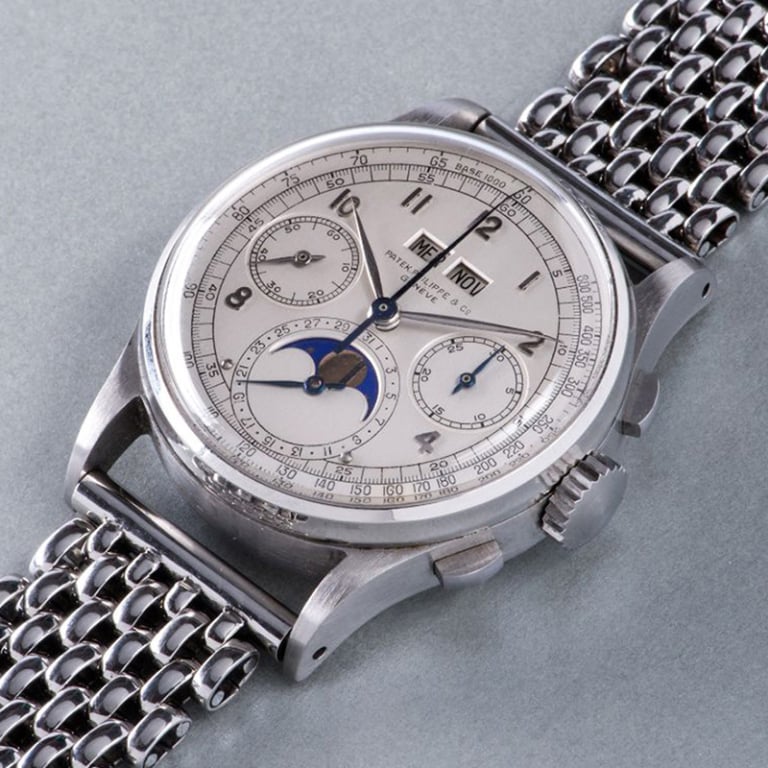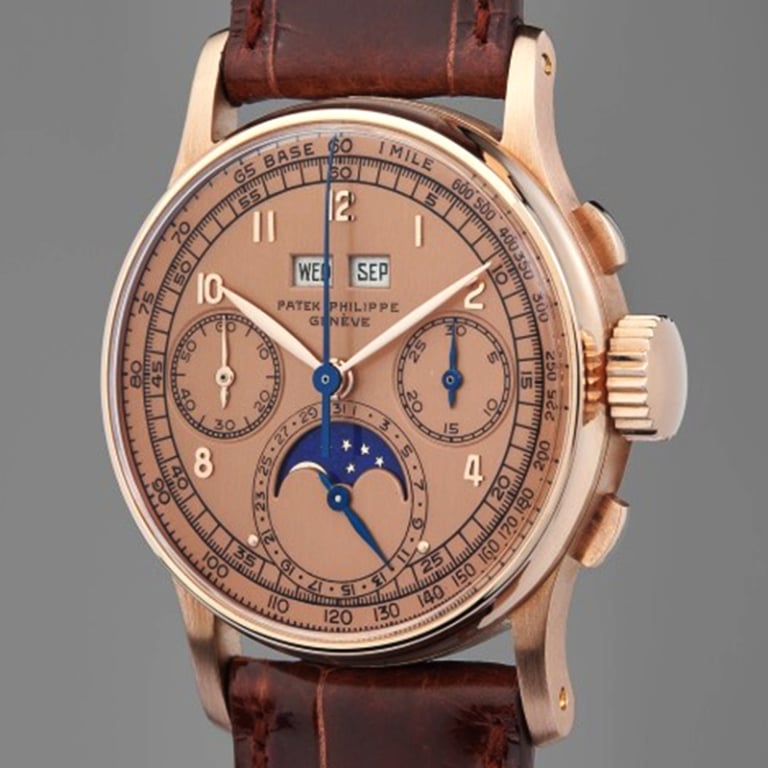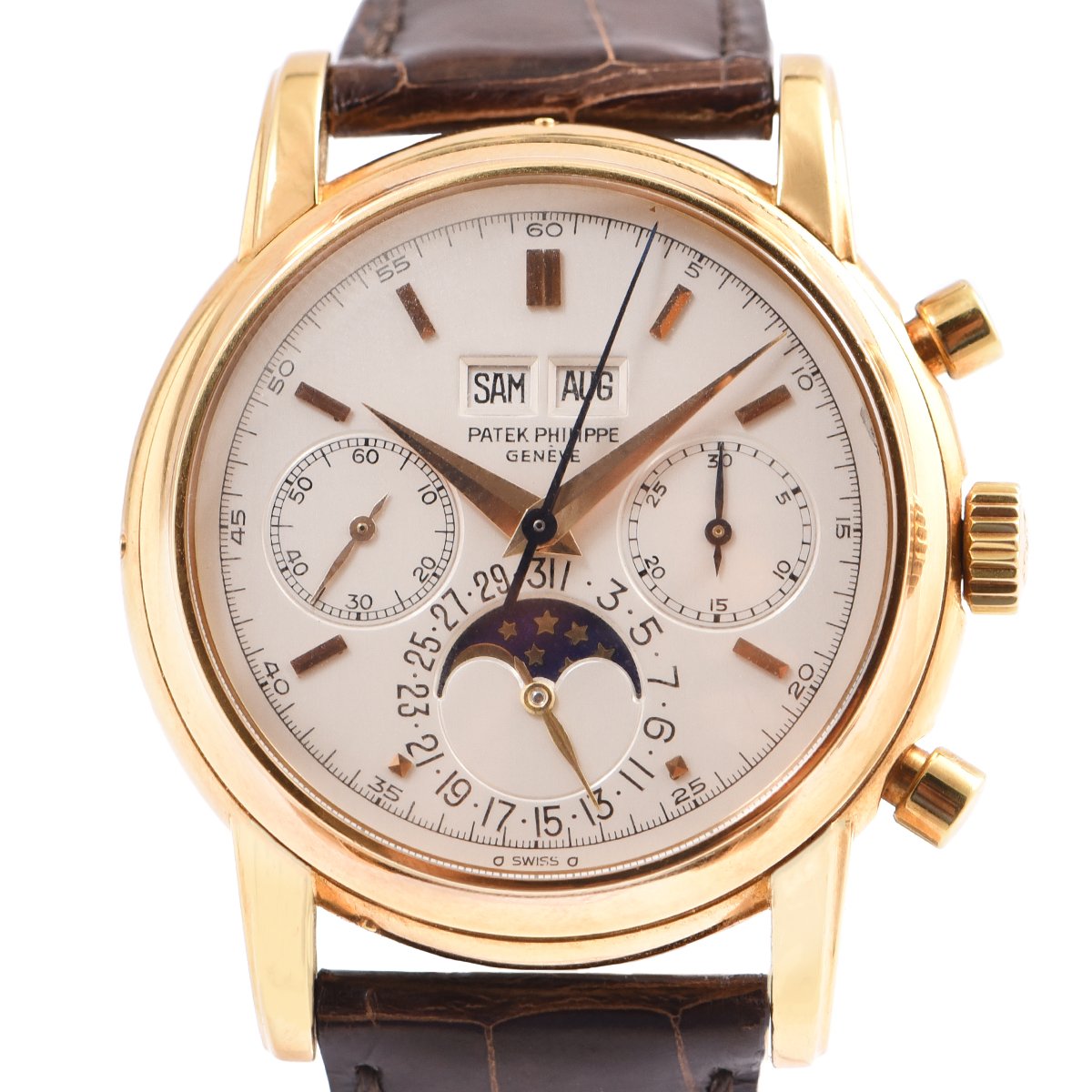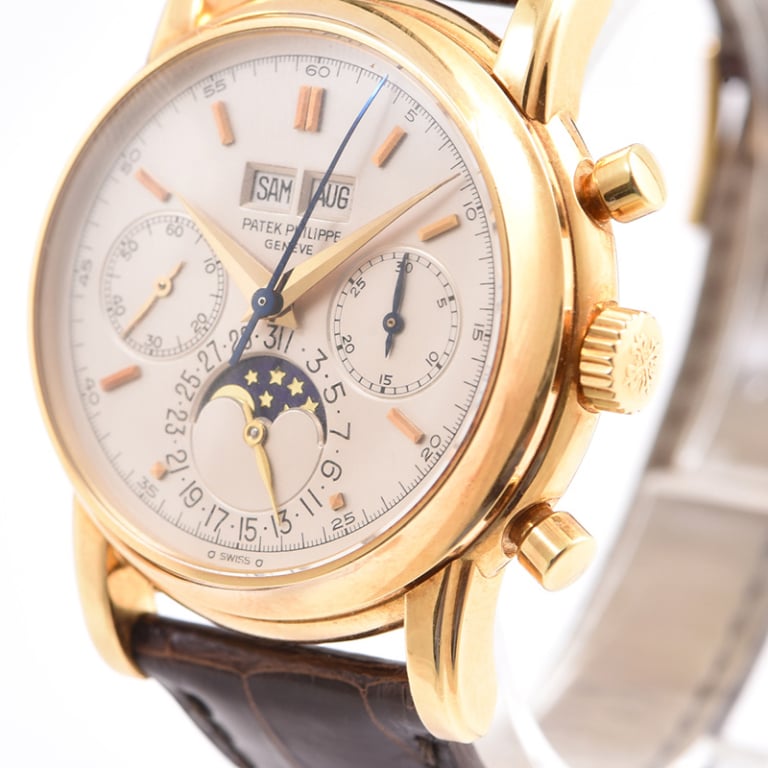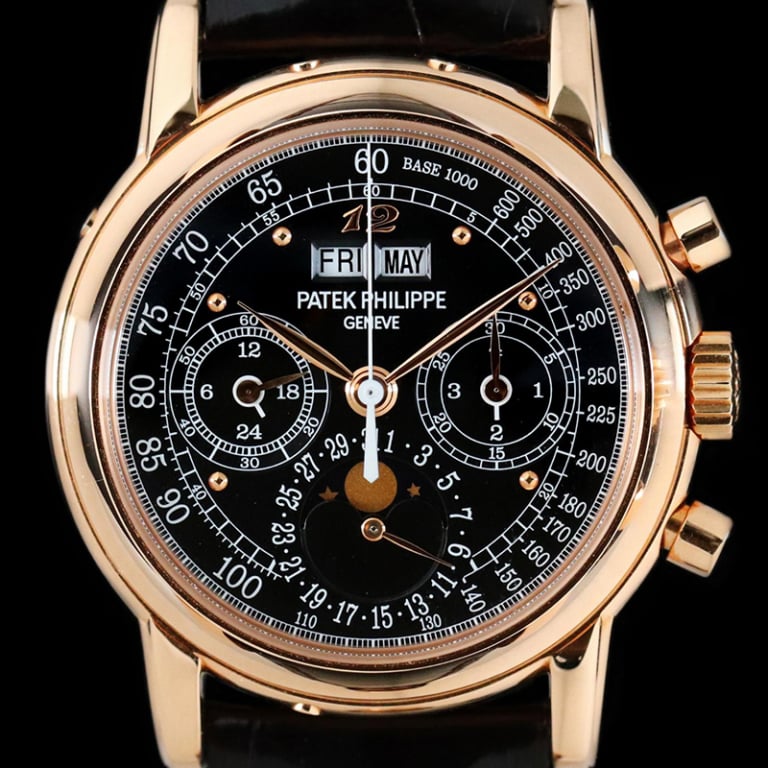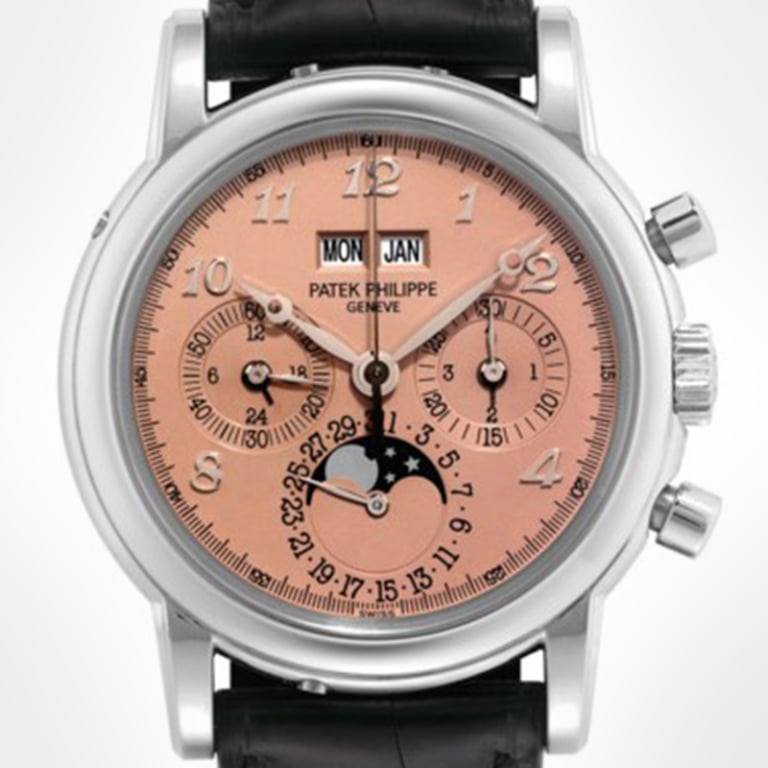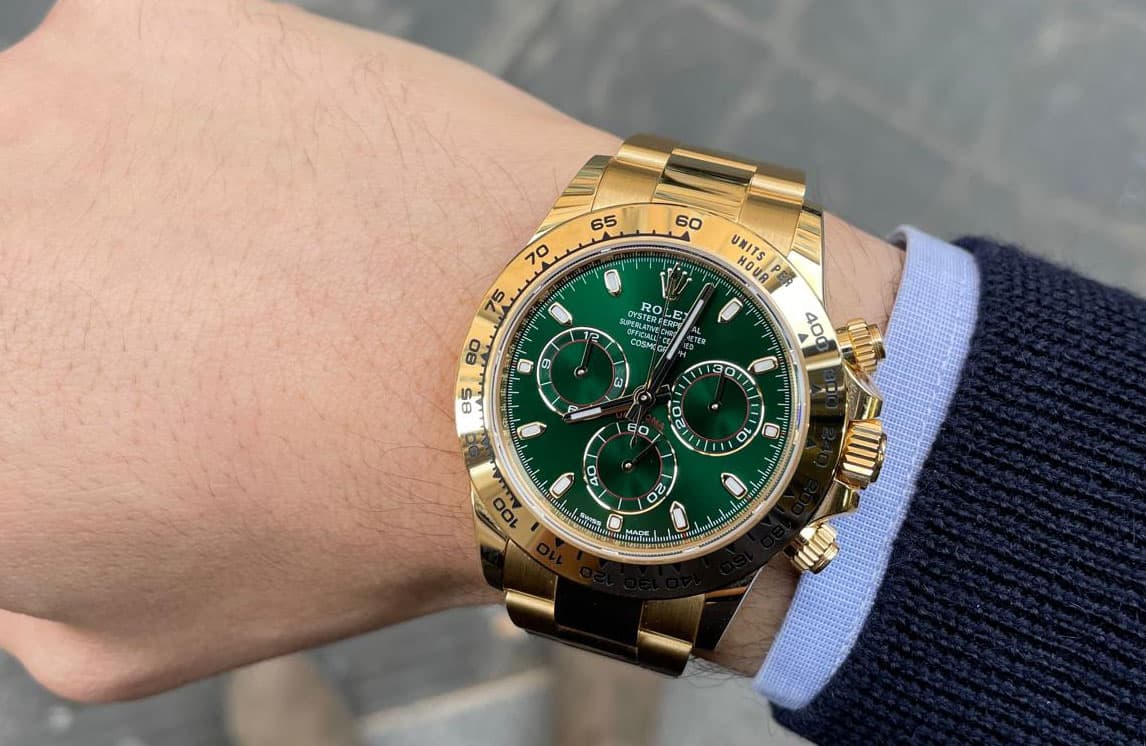How many people can boast of knowing when the very first mass-produced perpetual calendar with chronograph was produced? If you don't know, never fear. You get there by logic, as Sir. Arthur Conan Doyle through his admirable stories in "The Adventures of Sherlock Holmes" where deduction and reasoning always led to the solution of the riddle, which was difficult for anyone to solve.
And it is precisely logic that leads us to infer that this production can be traced back to the most prestigious Swiss maison according to many admirers, the Patek Philippe, which decided to couple its commercial fortunes with the creation of a perpetual calendar chronograph almost as if it were a real business card, to be displayed over time.
La Bonanno Jewelry, for more than 30 years on the market of the vintage, thus wishes to offer to the endless and growing population of enthusiasts and collectors a dynamic reconstruction, seasoned with some tasty details, of how this Reference has characterized not only the history of the wristwatch but at the same time the technological research and the stylistic direction closely dependent on it.
It was back in 1941 and the Patek Philippe, already in vogue for its high rate of research in the fine-tuning of its highly complex but perfectly functioning mechanisms, launched the Reference 1518 with such characteristics, unaware perhaps that this timepiece would become a unicum in the production history of mass-produced, high-complexity watches: the first step on a historic path not only for the brand but even for the entire specific industry in general. In fact, 1526, the world's first mass-produced perpetual calendar, had already been produced and launched. But the 1518 is more famous in that it is the world's first mass-produced perpetual calendar chronograph.
Again according to a reconstruction that is quite true, but never 100% confirmed and in contrast to the idea of the Patek Philippe always looking for something excellent to stand out, in 1941 a watch with such a high level of complication could only have been ordered by a bigwig from the very upper middle class or even from the military: after all, World War II had just begun!!!
Today it is indeed different. Movement complication is no longer or almost no longer a distinguishing feature among wristwatch manufacturers (design is done by computer and no longer by hand calculations and drawings...), but in 1941 this Patek Philippe Ref. 1518 was truly a jewel of horological evolution in just 35 mm. of solid matter, what today might be called a kind of killer application in computing!
That's why such a movement from the Swiss maison would in fact become the design pattern for an entire production spanning at least 70 years, relying on a dial with two double apertures inside at 12 o'clock, two chronograph registers at 3 and 9 o 'clock, a moon phase at the bottom and a circular date window at 6 o'clock. Inside it also boasted a 23-ruby movement, again of the highest Valjoux grade 13 by the aforementioned Swiss company.
Also, while the 1518 is indeed the original perpetual calendar chronograph as well as the absolute foundation of this incredible line, it is not necessarily the most desirable reference as a whole. When you look at it closely, the 35 mm. case and square pushers tend to make it more of a men's chronograph than something modern and for everyday wear.
But offsetting this aspect is that of the Patek Philippe 1518 to date there are very few working ones around the world and mostly they are in yellow gold. Others, but fewer in number, are in rose gold and a real rarity are those remaining in steel. And there are only four such stainless steel examples and they are considered some of the most valuable and rarest watches in the world. All were made during the war years and all four can be seen in detail in John Goldberger's historic book.
These watches are therefore impossible, to say the least, to price, except that the Phillips auction house recently fetched one for a record 11 Million Swiss Francs!!!
The Patek Philippe Reference 2499
In 1954 production of the Patek Philippe 1518 ended, and after 13 years came the 2499. Actually the new 2499 model seems to have been launched a little earlier, in 1951 to be precise, which would explain why the first examples of the 2499 were made together with the last pieces of the 1518, which have an end date of production dated precisely 1954. It will be one of the longest-lived watches in the world, with its almost 35 years of total production, a true icon in the industry because it will be produced in a few numerical examples.
The Patek Philippe 2499 is considered by many experts in the field to be the ultimate Patek Philippe, that is, the timepiece that captivates both by the old-world charm itself combined with an already more modern fit, projected into the evolution of a time now free of wartime conflicts in the West and wanting to savor the beauty of life by experiencing it with different eyes. But moreover, the Patek Philippe 2499 is probably also the most studied and analyzed of the perpetual chronographs in Patek Philippe.
Visually, the first series of the Patek Philippe 2499 is most striking because it has a case diameter of 37.5 mm. , widening the perspective of the watch sharply and imposingly compared to its ancestor(35 mm.), by the way considered by many as the perfect size to this day for a case to wear on the wrist. It also has square pushers and a dial with Arabic numerals applied to a tachymeter scale. In short, if we also look carefully at the hands, we find that the Patek Philippe 2499 is quite similar to its predecessor 1518. The whole is produced in yellow gold but also, in small numbers, in rose gold. Two examples in platinum also exist.
After this first series, the Patek Philippe changes design codes sharply in the second series of the 2499 (produced since the mid-1950s), in the third (roughly from 1960 to 1978, thus the most widely used in the world and automatically the least valuable), and also in the fourth series, indicative of a constant evolution aimed at the canons of an almost deliberately accelerated rather than desired modernity. One example? The sharp rounding of the pushers in the chronograph of the second series. Or the exclusion of the tachymeter scale on the dial with Arabic numerals in the third and fourth series. Besides being the most common, the third series therefore has no tachymeter, uses stick markers for the hours, round pushers but retains the acrylic crystal of its predecessors. So if you want to identify which series a Patek Philippe 2499 belongs to, just look at the dial!
Wanting then to elaborate as it is in the style of the Bonanno Jewelry, the difference between a third or fourth series Patek Philippe 2499 is actually minimal. In fact, many consider the fourth-series 2499 to be almost middle of the road, that is, a watch somewhere between the hallowed realms of vintage and modern. Produced between 1978 and 1985, the fourth series of the Patek Philippe 2499 (which has since taken the reference 2499/100), differs from the third series in that it uses a highly refined sapphire crystal in the case back.
Little to say then in the technical detail of much relevance, if anything there is to point out how the economic value of the Patek Philippe 2499 has rapidly increased. Professional appraisers price a rose gold watch over a million dollars, but if it has, for example, a Cartier signature on the dial, the value goes beyond a million dollars. And then there is the "platinum" factor.
The Patek Philippe 2499 in fact boasts only production in yellow and rose gold and nothing in steel but in platinum. We are actually talking about only two 2499/100 platinum examples in the world, both made on direct commission by the owner, Mr. Stern himself in 1985. One would be in the possession of the owners, the Stern family, who unceremoniously display it inside their museum in Geneva. The other would be sold to the general public during the auction that changed the course of history for the brand Patek Philippe: the April 9, 1989 auction entitled "The Art of Patek Philippe." In this historic auction, the Patek Philippe 2499 in platinum fetched a total of 418,000 Swiss francs, we repeat, in 1989 certainly not today, when the value of watches has notoriously gone up!
Interested to know that later this specimen ended up in the hands of Eric "Slow Hand" Clapton, famous watch enthusiast? And that it ended up again at auction for $3.63 Million thus defining the Patek Philippe 2499 as one of the most important watches on the planet? Yes, but it is probably much more important to remark that the Patek Philippe 2499 is considered the pinnacle of design Patek Philippe and with only 349 examples/pieces made in 35 years (less than 10 watches per year!).
The Patek Philippe Reference 3970
The Patek Philippe 3970 ushers in the brand's modern era. According to experts, it is a perpetual calendar chronograph that is well balanced to say the least, as perfect in its conception as only those who conceived its birth and making could produce.
The Patek Philippe 3970 began production in 1986, almost on the heels of the completion of the final two 2499/100 platinum examples, with an introductory retail advertising promotion for the new product. The novelty? Easy to say because the Patek Philippe 3970 is the first Patek Philippe to use not a chronograph based on the historic Valjoux movement, but instead one based on a Lemania movement named 2310.
And today the Lemania 2310 is considered one of the best movements in the world, surpassing any other single caliber over time and also used by several other manufacturers, do you think it is little? We at Bonanno Jewelers we know it well!
But there is more to it than that. Considered by connoisseurs to be a true snapback watch in its own right(i.e., "breakthrough" in its own right), first of all, the Patek Philippe 3970 takes a step backward in case size, coming out with a 36 mm. and no longer the 37.5 mm. of the 2499, making it almost as much of a step backward as if it were a new 1518. Also, the real news is that the case is being produced in all four of the most substantial metals(gold, white gold, rose gold and platinum), including for the first time a perpetual chronograph in white gold! And then-yes, you guessed it-there will also be a series for it, just like its direct predecessor 2499.
The first series of the Patek Philippe 3970 is executed in 1986 with a production run of about 100 watches, all in yellow gold. And to make things even more confusing (or increase the halo of mystery, you name it...), the 3970 actually launched on the market is joined by a sister reference named 3971. Both of these watches feature snap-in casebacks instead of the more modern screw-in casebacks. But while the Patek Philippe 3970 features precisely a solid, classic snap-in case back, the 3971 is itself equipped with a snap-in case back but with a fantastic sapphire crystal, which allows you to see the fascinating movement move without having to lift it!
In addition, the dial of the first series has leaf hands and baton hour markers, thus giving it a very similar appearance to that of a second 2499 series.
So here we are at the second series of the Patek Philippe 3970. It is a second series very, very similar to the first in terms of the front. There are indeed the same leaf hands and hour markers on the dial. The big difference on the front is that the hour registers match the dial: all the coloring is compact and uniform.
But it is on the back of the product that the second series of the Patek Philippe 3970 differs from the first in the most significant way to the point that instead of a snapback (i.e., turnaround) watch, we are faced with a potential step backward, at least at first glance. This is because in the early years of production of the 3970, the Patek Philippe was particularly attentive to the demands of its clientele, and there are even customized examples around.
As it is therefore easy to deduce, this second series of the Patek Philippe 3970 (produced between 1986 and 1991 and immediately followed by its sister reference 3971 with the screw-down sapphire case), is highly collectible, and although they are not priced consistently in the marketplace to date, it is possible that over time the differentiation between the first and second series watches vs. the third series 3970 will become more pronounced. Shall we make a bet?
Thus we come to the third series of the Patek Philippe 3970, those of the most popular and most widely available series on the market. The official reference would be 3970E with the "E " standing for "etanche" or if you prefer "waterproof" because now these Patek 3970 are either with a sapphire crystal case back, therefore exposed, or with a gold case back. On the front of the watch are the new features: baton hands instead of leaf hands and hour markers now with pointed tips. The dial print itself is much darker than in the first or second series, and you can see that the dial is now a bright, clear silver color that give it a very, very refined look.
Now the Patek Philippe 3970, with its size of 36 mm and this look of undoubted sophistication, is really something special. Moreover, it is really the watch that can even best define the corporate mission of the Patek Philippe, namely its pursuit of perfection combined with elegance and value. But the downside is that the quotations of the 3970 on the vintage market are low because there are so many 3970 third series on the market!!!?
Yes, according to the estimate based on its production over 18 years (always approximate), the number of the 3970 produced would be somewhere between 2,400 and 3,600 watches. Thus, it is more than 10 times the number of 1518 or even 2499 made. Consequently, the prices will be considerably lower than the 1518 and 2499, although there are cases that have already occurred in the market that indicate considerable figures for 3970 with special dials. In essence, it is always the condition of the watch overall that makes the difference.
There have also been cases of Patek Philippe 3970P (P stands for platinum), well priced because they feature a black dial and diamond hour markers. But let's be clear, many connoisseurs consider much more valuable than this model, the same 3970 in white gold with a black dial and no diamonds, if not even those in platinum! The dispute is still running.
At this point, however, enthusiasts are asking a legitimate question, a question also posed several times to We of the Bonanno Jewelry in all these years of activity: considering the factors in the field, what should be considered the last product in the family of 3970 that can take on a definite value on the value scale?
Very difficult to give a definite answer to this question because there really isn't one!?!? At least not in the same way that either the Patek Philippe 1518 in steel or the Patek Philippe 2499 in gold have been valued. These 3970 were made in platinum and in series and there are no known examples produced in steel although it cannot be totally ruled out that they exist. Therefore, again by logical deduction, the only ones 3970 that can become valuable are those with special dials, of which there are few around. Or those 3970 with dials in special colors or with styled numerals Breguet, these details can really make a difference.
However one is certain of a 3970 sold for nearly $340,000 during a Christie's auction in Hong Kong but this price always turns out to be less expensive than the average Patek Philippe 2499, whatever series it is. However, the Reference 3970 is still a production Patek Philippe of the highest caliber and although it might not be considered quite as one of the true vintage models in this family, its qualities remain intact.
The Patek Philippe Reference 5020
Later the Swiss watchmaker produces a new version, named 5020. The Patek Philippe 5020 is produced with the same Lemania caliber used for the 3970 and is housed in a large case, so large that the nickname "Television" is reserved for it. The dial, on the other hand, is composed with hands and numerals provided by the Breguet.
Unlike its great-grandchildren, the Patek Philippe 5020 was a total failure with the public and critics when it was launched in the early 1990s and, as such, production was discontinued after only two years. Because of this, experts estimate that fewer than 300 examples were made, thus placing the 5020 at the same level in terms of rarity as both the 1518 and the 2499!!!
For a long time the Patek Philippe 5020 was considered only by those collectors who were fans of the Swiss house until a 5020P, exactly the fifth one ever put up for sale at auction, was auctioned in New York by Bonhams of 2011 for the considerable sum of $338,000.
Since that time the value of the 5020 has been steadily increasing and its valuation has opened the eyes of collectors around the world, with the result that today a Patek Philippe 5020 in yellow gold is valued and sold as a 5970P.
In common with its predecessor 3970, the Patek Philippe 5020 would not seem to have its own version that is particularly desirable in terms of value and thus economic valuation in the marketplace. However, as only approximately 20 examples were produced in platinum, it can be said that a 5020P with a black dial and diamond hour markers (like the 3970 mentioned earlier), aspires to become a level-headed timepiece in the collector's field. Finally, returning to the topic of perpetual calendar chronograph quality. Patek Philippe, the 5020 still remains a production with less success although still a Patek production.
The Patek Philippe Reference 5004
As so often happens, after a flop, comes a top! After the immediate commercial failure on the market of the 5020, the Patek Philippe resumes vigor with a new chronograph called the 5004 with, at its core, even a split-second count. Yes, this new 5004 series hits the bull's eye and is absolutely iconic and beloved by Patek collectors.Patek Keeping the case at 36 mm, the Patek Philippe 5004 is made with a greater case depth to make room for the rattrapante mechanism, positioned above the proven and efficient Lemania caliber.
A thus unique, innovative and stunning watch with a perpetual calendar plus chronograph in seconds, being considered one of the most important watches of the modern era. The Patek Philippe 5004 was launched in 1996 and expert estimates indicate a production of about 12 pieces each year until the 5204 was introduced in 2012. Although made in all metals, the most coveted Patek Philippe 5004 today is the steel version, but the platinum version also has great appeal.
Therefore, rebus sic stantibus, We at the Bonanno Jewelry can say that every Patek Philippe 5004 is in itself a valuable watch. Moreover, one can choose some special specimens that we can define as the most valuable of the valuable!!!
And what are they? First of all there is the Patek Philippe 5004A where of course "A" stands for steel. A logical state of excitement spread through the market that did not subside even when it became known that, although at a price of more than $300,000 per example sold to the end customer by the parent company itself, the 5004As would have the purchaser's name engraved on the case back by the same Patek, precisely to discourage their posthumous sale on the private market. Mission failed, because shortly thereafter these Patek Philippe 5004As appeared at auction. For example, one example was sold at Christie's Hong Kong for $409,000!
A note of color? A close dialogue has been going on for quite some time among the most avid collectors of the production Patek Philippe, both to increase the atavistic thirst for knowledge but also to outline a controversial note of recent times.
It all originated the moment the Patek announced (directly herself or her dealers?), that she was producing a series of new 5004 examples exclusively in steel to enhance the uniqueness of the same.
There are other special 5004s on the market, though, such as those with special dials and even some with factory bracelets Patek. But all this talk falls apart when it comes to the Patek Philippe 5004T. Yes, this is truly a unique piece because it is made of titanium that was sold on Only Watch in 2018 for the considerable sum of $3.98 million, more than an already mentioned earlier Clapton 2499.
The Patek Philippe Reference 5970
Finally, coming to the present day, here is the Patek Philippe Reference 5970, another the best of in the history of Patek Philippe's achievements. In fact, according to some admirers (and of course even here a close controversy has begun), we are talking about perhaps the best watch that Patek Philippe ever made. Some describe it by extolling the proportion of its features, others even call it "the last of the great Patek Philippes."
The Patek Philippe Reference 5970 was produced between 2004 and 2011, later changing to the 5270. On closer inspection, it is a production cycle of only seven years, making it the shortest production run of any perpetual chronograph Patek. This very important fact combined with a new modern 40 mm case . , a perfectly balanced dial with the inclusion of a tachymeter scale, and a totally different appearance from its ancestors, make the Patek Philippe 5970 a truly remarkable watch! Inside the 40 mm. case is the same Lemania-based movement we saw introduced by the 3970 and confirmed in the 5020.
Also aesthetically, the clean and legible scales of the two sub dials at 9 and 3 o'clock are reminiscent of 3970.
With the Patek Philippe Reference 5970 we have production in four different metals, with the platinum model standing out in the ranking of the most coveted. But doing the tare with this reasoning, many believe instead that it is the 5970J (i.e., in yellow gold), which is the rarest. In fact, in this version there are not too many variations in the dial on the 5970, although a few pieces have the Tiffany signature as well as occasionally there is something special, ordered ad hoc directly from the parent company.
The Patek Philippe 5970 remains, however, and without any doubt, one of the safest investments in this multifaceted and fascinating universe. Case in point? The New York rotogravure published an article in 2005 questioning whether the 5970G was actually worth the then estimated price of $89,600. Well, today almost 15 years after this article, the same watch is worth about $145,000 on the second-hand market!!! More than any other safe haven asset then!!!
As if that were not enough, a Patek Philippe 5970J with champagne-colored dial was valued at $353,000 less than 16 months ago and that is for this rare color of its dial, not forgetting the purchase price of $150,000 compared to a regular 5970J. For the rose, white and yellow gold models we expect to pay about $130,00 to $150,000 while the same, that is, about $175,000, for a platinum example. So on the used market all 5970s are on the rise, with one platinum model reaching $217,000 some time ago!
At this point a question arises: is there a 5970 more valuable than all the others?
Very, very difficult to establish with certainty. Some people like to argue that all Patek Philippe 5970s are worthy in terms of quality and thus valuation. But if we really wanted to go looking for one, the most valuable of all... We could give this award to the Patek Philippe 5970 that always belongs to our Eric "Slow Hand" Clapton, already as seen owner of a 2499. Indeed, there are photos of the great guitarist and singer taken at the 2011 Italian Grand Prix, wearing what appeared to most to be precisely a white metal Patek Philippe 5970 with numerals Breguet.
Beware, however: even a seemingly more insignificant variation to normal production can affect the price: for example, white hour and minute hands priced a 5970 with a black platinum dial at as much as 225,000 Swiss francs at Sotheby's Geneva in November 2016.
In conclusion and regardless, the Patek Philippe 5970 always remains the pinnacle of the modern watch collection.
